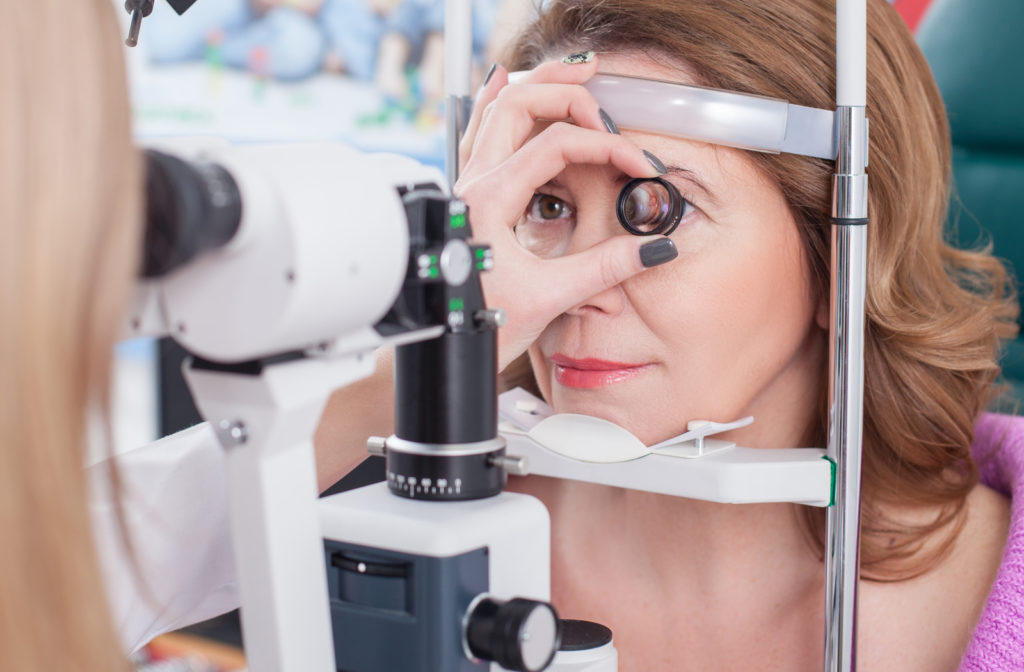Regular eye exams are vital for maintaining good eye health since they allow your optometrist to look for signs of trouble and diagnose potentially serious conditions as soon as possible.
But what does a complete eye exam include? Read on to learn about what a typical eye exam entails.
Preliminary Questions
Before your exam, your eye care professional will ask you a few questions about your medical history and your family’s medical history. Try to provide as much accurate information as you can, since this information will help your optometrist tailor the exam to best suit your needs.
Questions may include:
- What medications are you currently taking?
- Does your family have a history of eye disease? If so, which diseases?
- Have you experienced any major health problems in the past few years? If so, what were they?
If you require prescription eyewear, including glasses and contact lenses, you should bring them with you to show your optometrist. Depending on your needs, they may review other vision correction options with you and may be able to suggest alternatives to reduce problems such as eye strain and fatigue. Your visual needs may differ slightly depending on whether you are at home or at work or at school.
The Slit Lamp Test
A slit lamp is a specialized microscope that directs a beam of light into your eye, allowing your optometrist to examine your eye’s interior structures, including the cornea, eyelids, iris, pupil, conjunctiva, lens, sclera, and retina. This gives your optometrist insight into the overall health of your eyes.
Glaucoma Testing
Glaucoma testing typically relies on two tests: noncontact tonometry and applanation tonometry.
Noncontact Tonometry
Non-contact applanation tonometers use a gentle puff of air to test your eye’s resistance. By measuring the eye’s resistance, your optometrist can gauge how high your eye’s internal pressure is. High internal pressure may be cause for concern, and will likely warrant further testing.
Applanation Tonometry
Like its noncontact counterpart, applanation tonometry is used to measure the eye’s internal pressure. The applanation tonometer uses a smooth, flat-tipped cone to gently apply pressure to the eye. The device applies only enough pressure to temporarily flatten your cornea and measures your eye’s resistance.
Visual Field Testing
Visual field testing is used to determine how far your peripheral vision extends. There are a couple of ways this can be tested.
Automated Perimetry
Automated perimetry relies on a screen that will show you a series of flashes or blips both in front of you and in your peripheral vision. Each time a new flash pops up, you will have to hit a button to let your eye care professional know you can see it. How fast you hit the button also allows your optometrist to gauge your reaction time.
This test can also be done with images that slowly crawl into your field of view. Again you will have to indicate when the object enters and exits your field of view, usually by pressing a button.
A Confrontation Exam
A confrontation exam is a similar test to automated perimetry, with the key difference being that your optometrist will be moving real objects in physical space in front of you as you cover one eye at a time. Just like in the previous test, the object will enter and exit your field of view, and you will have to register when this happens and communicate this information to your optometrist.

Color Vision Test
This test is used to assess your color vision. Your optometrist will show you a variety of images made up of different sized dots of different colors. The two different colors are used to produce a number or letter within the image, which can only be perceived if your eyes are able to differentiate between the two colors.
Patients who can’t tell the two colors apart, and therefore can’t see the number or letter, likely have some form of color blindness.
Eye Control Test
Accurate mobility and control of your eyes are vital for good vision as they allow you to lock onto different objects in your field of view. An eye control test will have your optometrist or ophthalmologist moving an object in and around your vision and will ask you to keep your eyes locked on the object as he or she moves it. Healthy eyes should be able to fixate on the object and track it through 3D space accurately.
This test is usually done with first one eye and then the other covered. This forces you to track the object using only one eye, giving your optometrist a more accurate picture of each eye’s ability.
Visual Acuity Test
Easily one of the most recognizable visual tests, visual acuity tests how well you can see large and small letters. A board with incrementally smaller letters or characters will be presented to you, and you will have to read off each line until you can no longer make out what the letter or character is being shown. This test is used to determine your overall clarity of vision.
If you have prescription glasses or contacts, this test may also include a refractive lens component. Your optometrist will bring a series of lenses over your eyes and swap different ones in and out, one at a time, until you can read the smaller lines of lettering clearly. The lens that gives you the best vision is your prescription. Many patients have 2 slightly different prescriptions, one for each eye.
Safeguard Your Vision With an Annual Eye Exam
Annual eye exams are a vital tool for fending off degenerative diseases and maintaining both your eye health and the quality of your vision.
